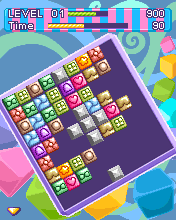
There are things that should never be turned on their side or held upside down. To name just a few: ant farms, convertible cars, cups of hot liquid, infants, chess boards, tortoises, candles, breakfast trays, metronomes, and drum kits all work best when confined to a single axis, deviation from which is at best inconvenient, at worst homicidal.
Until recently, we thought puzzle games were the same. Tetris's formula has been so successful that only a foolish developer would dare to venture very far from the safe routine of blocks falling onto other blocks from above, lining up, and disappearing.
In many respects, in fact, Brain Shock vindicates this cautious policy. To reach the end of a level, you need to keep the screen clear of blocks by lining up three or more of the same colour. If you manage to line up more than three, you get bonus points. Likewise, if after a cluster of same-coloured blocks lines up and disappears, and the blocks that fall into the resulting space are also the same colour, a chain reaction takes place and you get more bonus points.
We could cut and paste the above paragraph into almost every 'match three' styled puzzle game review without fear of inaccuracy. However, Brain Shock departs from the mainstream in a bold new direction. You see, rather than move the blocks, you move the very playfield itself.
The blocks are actually completely immobile, spread randomly across the bottom of a given level, and heaped like snow on the ledges of solid brick that punctuate them. You have three ways of trying to bring same-coloured blocks into conjunction: one, nudge the board left or right with '4' or '6'; two, rotate the board 90 degrees at a time with '1' and '3'; and three, flip the board 180 degrees with '8'.
The blocks on the board are subject to gravity, and will always fall down towards your thumbs, so the challenge is to work out how the blocks will be situated once you execute one of the three highly disruptive moves.
Nudging from side to side is easy enough – all of the blocks will jump except for those that are pushed up against a wall, a ledge, or another block that can't move either.
With the other two, though, working out how everything will land is a near-impossible mental feat. If you imagine trying to arrange scrabble letters in such a way that when you tip them 90 or 180 degrees they collapse to spell a word, you'll get a sense of the game's daunting challenge.
Which isn't to say that you won't master it, nor that developer C4M isn't clearly aware of the issue. Brain Shock has two game modes, Puzzle and Arcade, and the former is as much a tutorial as game, patiently easing your mind into the habit of visualising outcomes by affording you a limited number of moves to bring a small number of blocks together.
Arcade mode, meanwhile, gives you plenty of time to work out what you're doing. As is the norm, you lose the game when a block is touching the ceiling at the point when the next row slides up through the floor. Although it accelerates, the allowance of time before each new rank of blocks arrives is generous.
When all else fails, of course, you can resort to button-mashing – tumbling the board around and around and hoping that the right blocks come together. Disappointingly, this method is quite effective, and it's all too easy – and tempting – to fall back on it when the going gets tough.
Of course, we wouldn't dream of blaming the game for whatever unscrupulous approach a player might take to it but, equally, it's impossible not to question the difficulty curve of a title in which it takes a good deal of practice for effort to be more effective than random twirling.
Nevertheless, for all that it doesn't quite work Brain Shock is a bold experiment in puzzle game design, and we genuinely hope that C4M's seed of innovation will bear plenty of sequel-shaped fruit.
Brain Shock

